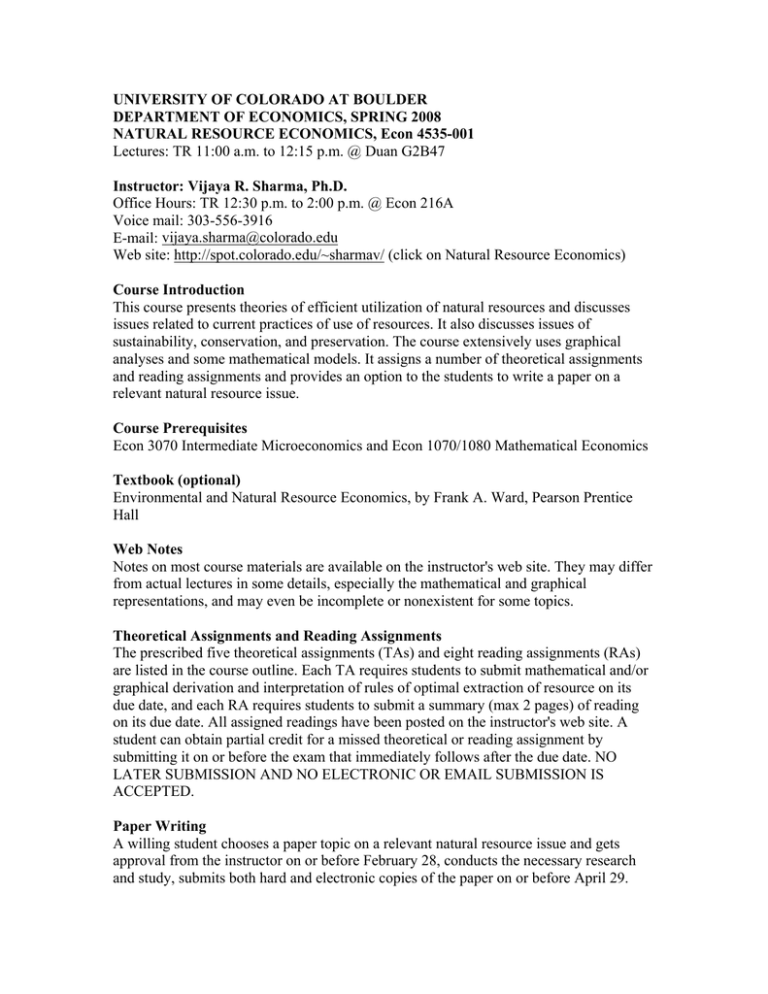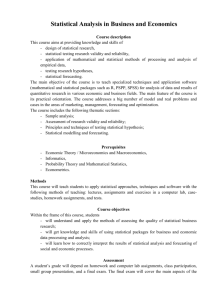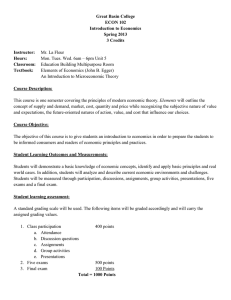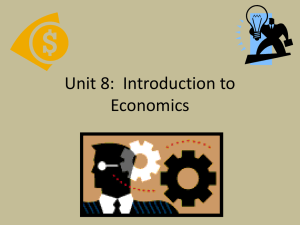
UNIVERSITY OF COLORADO AT BOULDER
DEPARTMENT OF ECONOMICS, SPRING 2008
NATURAL RESOURCE ECONOMICS, Econ 4535-001
Lectures: TR 11:00 a.m. to 12:15 p.m. @ Duan G2B47
Instructor: Vijaya R. Sharma, Ph.D.
Office Hours: TR 12:30 p.m. to 2:00 p.m. @ Econ 216A
Voice mail: 303-556-3916
E-mail: vijaya.sharma@colorado.edu
Web site: http://spot.colorado.edu/~sharmav/ (click on Natural Resource Economics)
Course Introduction
This course presents theories of efficient utilization of natural resources and discusses
issues related to current practices of use of resources. It also discusses issues of
sustainability, conservation, and preservation. The course extensively uses graphical
analyses and some mathematical models. It assigns a number of theoretical assignments
and reading assignments and provides an option to the students to write a paper on a
relevant natural resource issue.
Course Prerequisites
Econ 3070 Intermediate Microeconomics and Econ 1070/1080 Mathematical Economics
Textbook (optional)
Environmental and Natural Resource Economics, by Frank A. Ward, Pearson Prentice
Hall
Web Notes
Notes on most course materials are available on the instructor's web site. They may differ
from actual lectures in some details, especially the mathematical and graphical
representations, and may even be incomplete or nonexistent for some topics.
Theoretical Assignments and Reading Assignments
The prescribed five theoretical assignments (TAs) and eight reading assignments (RAs)
are listed in the course outline. Each TA requires students to submit mathematical and/or
graphical derivation and interpretation of rules of optimal extraction of resource on its
due date, and each RA requires students to submit a summary (max 2 pages) of reading
on its due date. All assigned readings have been posted on the instructor's web site. A
student can obtain partial credit for a missed theoretical or reading assignment by
submitting it on or before the exam that immediately follows after the due date. NO
LATER SUBMISSION AND NO ELECTRONIC OR EMAIL SUBMISSION IS
ACCEPTED.
Paper Writing
A willing student chooses a paper topic on a relevant natural resource issue and gets
approval from the instructor on or before February 28, conducts the necessary research
and study, submits both hard and electronic copies of the paper on or before April 29.
Examinations
Exam dates are firm. NO MAKEUP EXAM SHALL BE GIVEN.
Midterm 1: Feb 14, Thursday
Midterm 2: Mar 20, Thursday
Final: May 5, Monday at 1:30 P.M.
Grading Policy
The course grade will base on performances in two midterm tests, one paper presentation,
theoretical assignments, readings, and the final exam:
Midterm 1
20%
Midterm 2
20%
Final Exam
20%
Paper Write-up
20%
Theoretical assignments
10%
Readings
10%
If you miss a midterm for any reason or prefer not to write a paper, the remaining exams
and/or the paper shall be weighted 26.66% each. If you do not miss any midterm and also
write and submit a paper, the worst score among the two midterms and the paper shall be
dropped and the remaining exams and/or paper shall be weighed 26.66% each if that
improves your grade.
Course Outline and Tentative Schedule
1. INTRODUCTION, INTER-TEMPORAL DECISIONS AND RELATED
CONCEPTS – Jan 15, 17, 22
Syllabus, requirements and grading policy; Resource Taxonomy – Resource Flows,
Natural Resources (Renewable and Non-renewable), Environmental Resources,
Reasons of Studying Natural Resource Economics – involves inter-temporal
decisions, pervasive market failure, potential irreversible consequences, and
multidisciplinary knowledge; Broad Issues – Efficient utilization, Sustainability,
Resource Scarcity and Economic Growth; Intertemporal Graphical Model: Rate of
time preference, concept of discounting, optimal allocation rule, marginal user cost
and scarcity rent
RA #1 due on Jan 22: The Cost of Fur (news piece published in the Economist of
March 1, 2001)
2. BENEFIT – COST ANALYSIS, VALUES OF RESOURCES, AND NONMARKET
VALUATION TECHNIQUES – Jan 24, 29, 31, Feb 5, 7
TA #1 due Jan 24: Draw the inter-temporal graphical model with proper labels,
explain the curves, and interpret the equilibrium condition of optimal intertemporal allocation
Brief introduction of benefit – cost analysis: net present value, benefit-cost ratio,
internal rate of return, and the pay back period (simple v. discounted); evaluation of
mutually exclusive projects (NPV, incremental B/C, incremental IRR)
RA #2 due on Jan 31: Conservation Revisited, by John Krutilla, from American
Economic Review
Use v. Non-use values, types of use values, types and bases of nonuse values –
option, discovery and existence value and the issues of uncertainty, lack of
information, and possible irreversible consequences, also the issues of asymmetry of
technological progress, inability to reproduce unique resources, and evolving
preferences; Economic value v. Environmental value and the issue of non-human
value; Techniques of nonmarket valuation – hedonic price method, travel cost
method, and contingent valuation method
RA #3 due on Feb 7: Using Contingent Valuation to Estimate a Neighborhood’s
Willingness to Preserve Undeveloped Urban Land, by Breffle, Morey, and
Lodder
3. TRENDS OF RESOURCE SCARCITY – Feb 12
RA #4 due Feb 12: Trend of Natural Resource Commodity Prices, by Margaret
Slade, from Journal of Environmental Economics and Management
Trends of Economic Scarcity – Price, marginal extraction cost, and rent, Factors
Mitigating Scarcity, Recent findings in the literature
MIDTERM 1: FEB 14, THURSDAY
4. NONRENEWABLE RESOURCES AND ENERGY – Feb 19, 21, 26, 28, Mar 4
Reserve Taxonomy – Current Reserves, Potential Reserves, and Total Resource
Endowment; Resource Pyramid and Warehouse Concept of Reserves; Two Markets –
Asset Market and Flow Market; Two-Period Hotelling Model – Mathematical
Derivation, Equilibrium Conditions, Interpretations, and link with the inter-temporal
graphical model
TA #2 due Feb 26: Set up the mathematical form of Hotelling model, derive the
first order conditions, and interpret them.
Best Reserve First Principle, Time Path of efficient prices and scarcity rent under
Zero MEC, Constant MEC, Increasing MEC, Impacts of changes in discount rate,
Price of substitute, Stock, MEC, and Demand, Extraction under Monopoly, Negative
externality, Effect of Price Ceiling
RA #5 due Mar 4: The Economics of Resources or the Resources of Economics,
by Robert Solow, from American Economic Review
Trend of oil prices, reasons, and inferences; diversification, conservation, and
development of alternative energy efforts
5. WATER RESOURCES – Mar 6, 11, 13, 18
Ground Water Allocation: Safe Yield Use Principle of maintaining water table in
aquifers, optimal rate of depletion of aquifers; Surface Water Allocation: Equimarginal principle of allocating surface water – mathematical derivation and
graphical model, scarcity rent of water, marginal user cost, and marginal cost pricing
of water
TA #3 due Mar 13: Set up the mathematical two-user water allocation problem,
derive the first order conditions, and interpret them.
Colorado River Compact, Management of Water Resources in Colorado, Water
Rights Market, Pricing of Drinking Water and Conservation: Average v. marginal
cost pricing, Practice of tap fees, Price vs. watering restrictions
MIDTERM 2: MAR 20, THURSDAY
6. TIMBER HARVESTING MODEL AND FORESTRY ISSUES – Apr 1, 3, 8
Growth characteristics of timber, stumpage value, the MAI rule of harvesting
Net present value from timber harvesting, Single Crop Optimal Harvesting Period –
mathematical derivation, graphical representation, and interpretation
Optimum Rotation Model, Site Expectational Value, Addition of non-timber values
TA #4 due Apr 3: Set up the mathematical single crop timber harvesting model,
derive the first order condition, and interpret it. Also, discuss the change in the
rule when infinite rotation is allowed.
Forestry issues: roadless and wilderness v. roaded, protection against wildfire and
invasive species, timber management v. multiple use management, below-cost timber
sales, allowing participation of environmental activist organizations in bidding for
clear-cutting of forests
RA #6 due April 8: Free Market Forestry, by Mark Muro, from the Denver
Rocky Mountain News, Sunday, June 1, 1997, pp. 1B
7. FISHERY SUSTAINABLE YIELD MODEL AND PROBLEMS OF OPEN
ACCESS – Apr 10, 15, 17, 22
Fishery growth characteristics, Minimum threshold stock, Maximum sustainable
stock, Physical relationship between stock and yield, Concept of Maximum
Sustainable Yield (MSY); Economic model (graphical presentation) – assumptions,
fishing effort, relationship between fishing effort and sustainable yield, Revenue and
Cost graph, Optimum sustainable stock and yield, interpretations
TA #5 due Apr 17: Clearly draw the fishery graphical model, label the axes,
show the optimum sustainable harvesting point, and interpret the optimal point.
Regulatory system of controlling open access fishing, tax on fishing, Coase theorem:
privatization, tradable fishing quotas, and community ownership
RA #7 due April 22: Economic Incentives and Poaching of the One-Horned
Indian Rhinoceros in Nepal, from the Poverty Reduction and Environmental
Management No. 1, Jan 2005
8. POPULATION, ENVIRONMENT, AND ISSUE OF SUSTAINABILITY – April 24,
29, May 1
Neo-Malthusian Perspective on Population, Economic model of family size, Modern
theory of demographic transition, Mutual relationship between economic growth and
population growth, Impact of population growth on environment – downward spiral
hypothesis, induced innovation hypothesis, Ecological perspectives and Ecological
Economics
RA #8 due Apr 29: Sustainability - An Economist's Perspective, by Robert
Solow, from Economics of the Environment, Selected Readings, 3rd edition,
edited by R. Dorfman and N. Dorfman, W.W. Norton & company, 1993, pp. 179187
John Rawl's sustainability principle of nondeclining welfare, Solow-Hartwick
sustainability rule of nondeclining capital, Issue of Substitutability of Natural Capital
with Manmade Capital, Weak Measure of Sustainable Development, Strong Measure
of Sustainable Development, Empirical Findings on Sustainable Development in
Selected Countries, Safe Minimum Standard of Use (SMS), Daly’s Steady-State
Principles
FINAL EXAM: MAY 5 MONDAY AT 1:30 P.M.
Accommodations for Students with Documented Disability
If you qualify for accommodations because of a disability, please submit a letter to me
from Disability Services in a timely manner so that your needs may be addressed.
Disability Services determines accommodations based on documented disabilities.
Contact 303-492-8671, Willard 322, or www.Colorado.EDU/disabilityservices.
Absences due to Religious Observances
Campus policy regarding religious observances requires that faculty make every effort to
reasonably and fairly deal with all students who, because of religious obligations, have
conflicts with scheduled exams, assignments or required attendance. If you have any
such conflict, please inform the instructor at least two weeks in advance to make a
reasonable arrangement or adjustment according to the University policy, which can be
seen at http://www.colorado.edu/policies/fac_relig.html.
Classroom Behavior Policy
Students and faculty each have responsibility for maintaining an appropriate learning
environment. Students who fail to adhere to behavioral standards may be subject to
discipline. Faculty have the professional responsibility to treat students with
understanding, dignity and respect, to guide classroom discussion and to set reasonable
limits on the manner in which students express opinions. See policies at
http://www.colorado.edu/policies/classbehavior.html and at
http://www.colorado.edu/studentaffairs/judicialaffairs/code.html#student_code.
Honor Code
All students of the University of Colorado at Boulder are responsible for knowing and
adhering to the academic integrity policy of this institution. Violations of this policy may
include cheating, plagiarism, aid of academic dishonesty, fabrication, lying, bribery, and
threatening behavior. All incidents of academic misconduct shall be reported to the
Honor Code Council (honor@colorado.edu; 303-725-2273). Students who are found to
be in violation of the academic integrity policy will be subject to both academic sanctions
from the faculty member and non-academic sanctions (including but not limited to
university probation, suspension, or expulsion). Additional information on the Honor
Code can be found at http://www.colorado.edu/policies/honor.html and at
http://www.colorado.edu/academic/honorcode.







